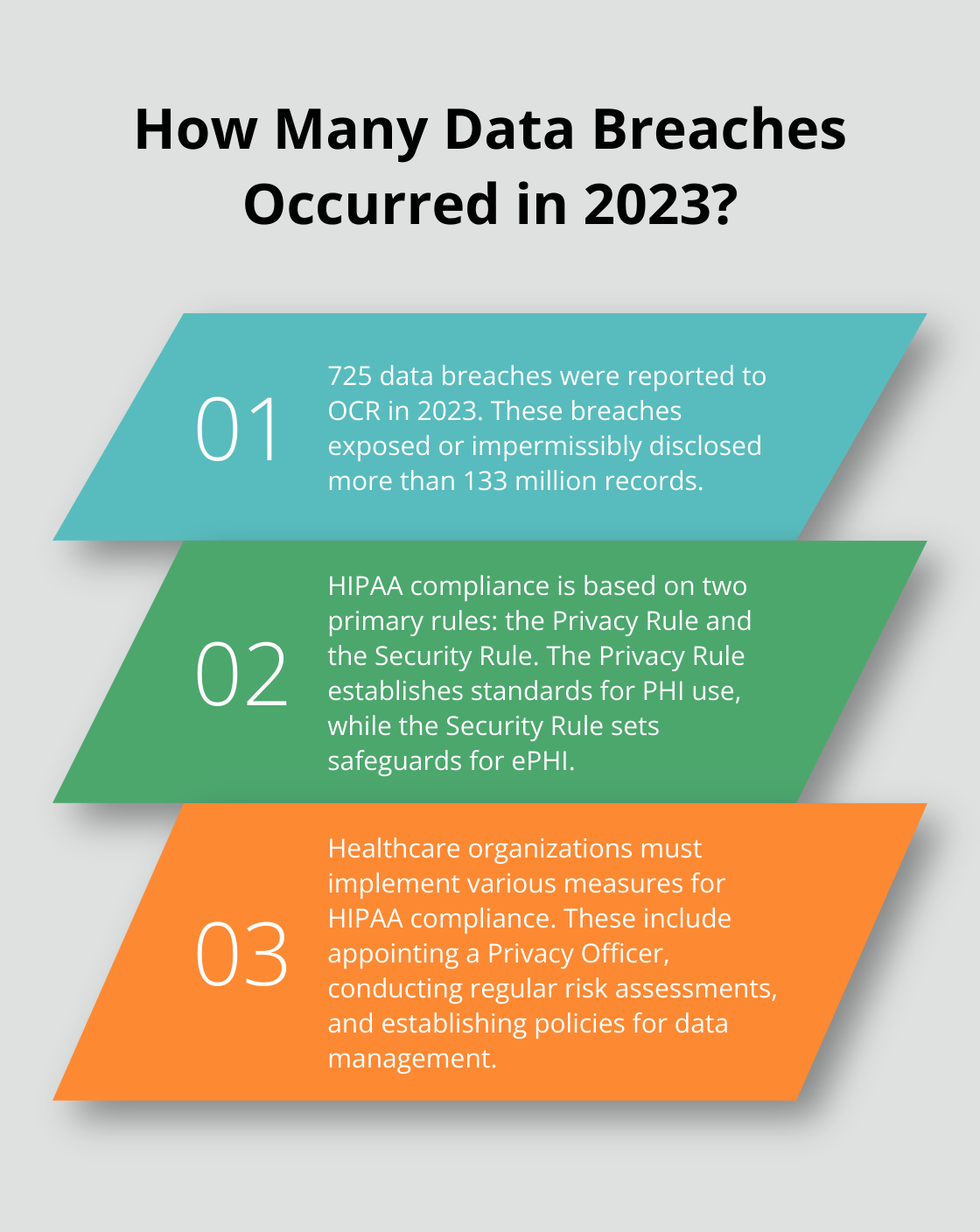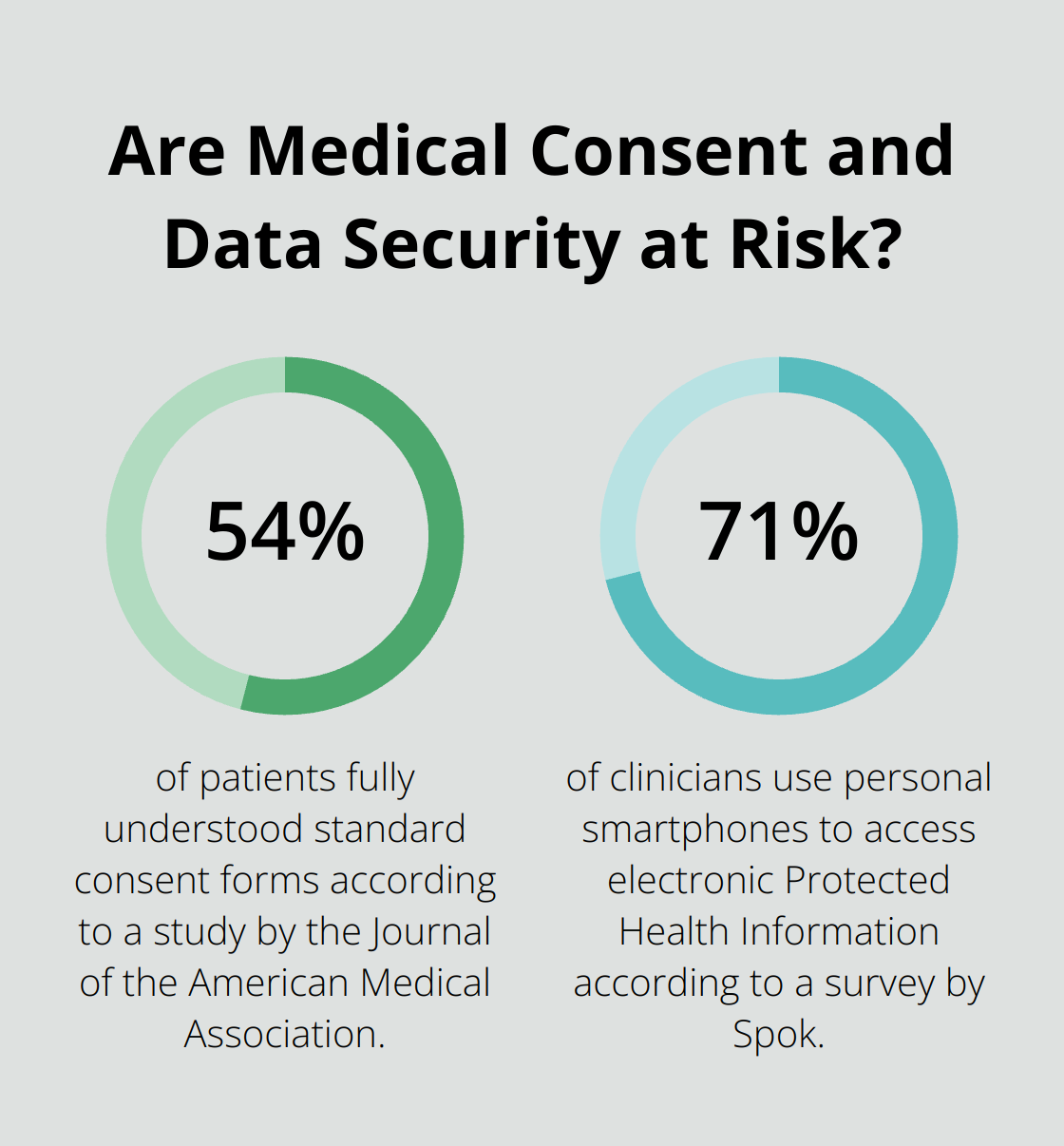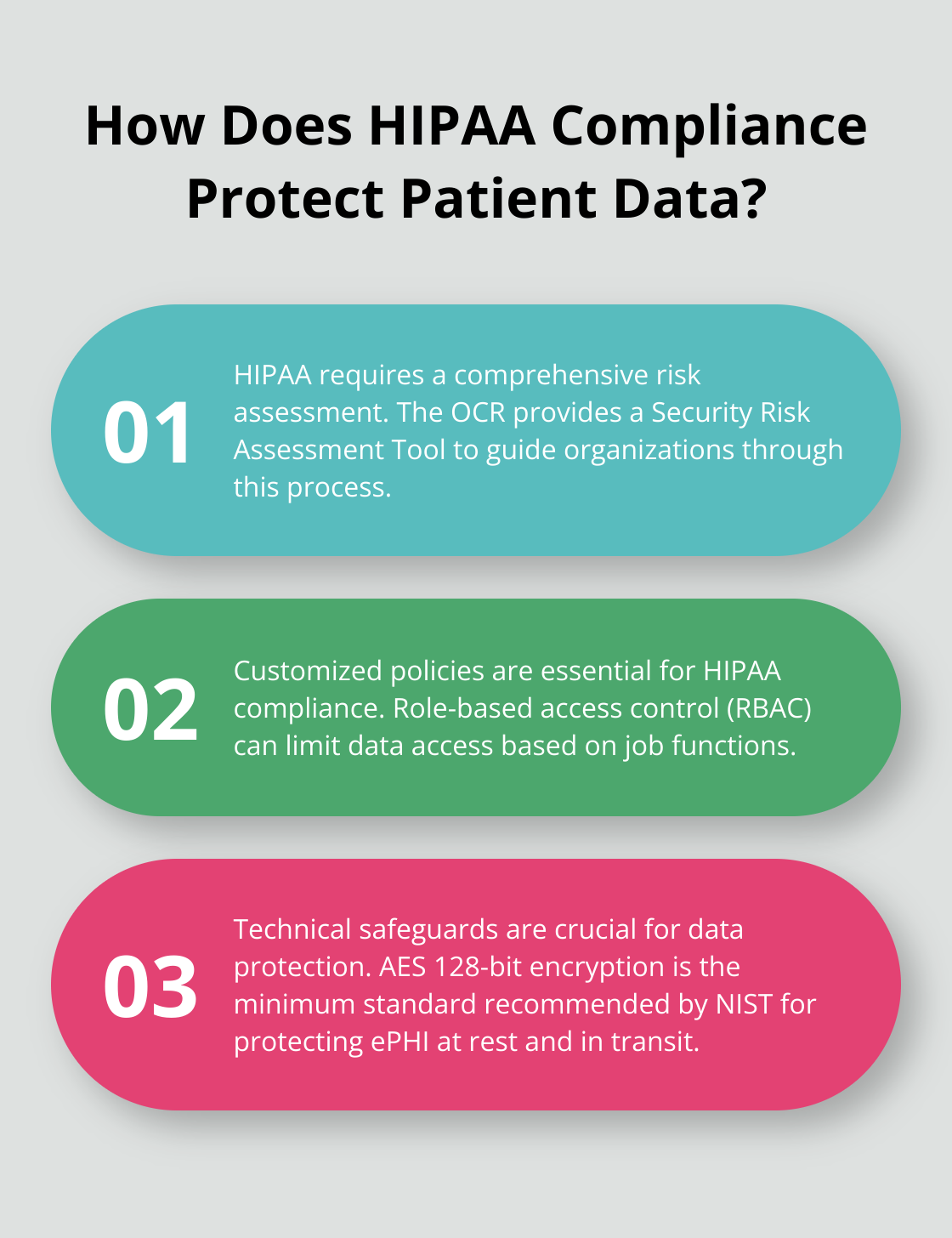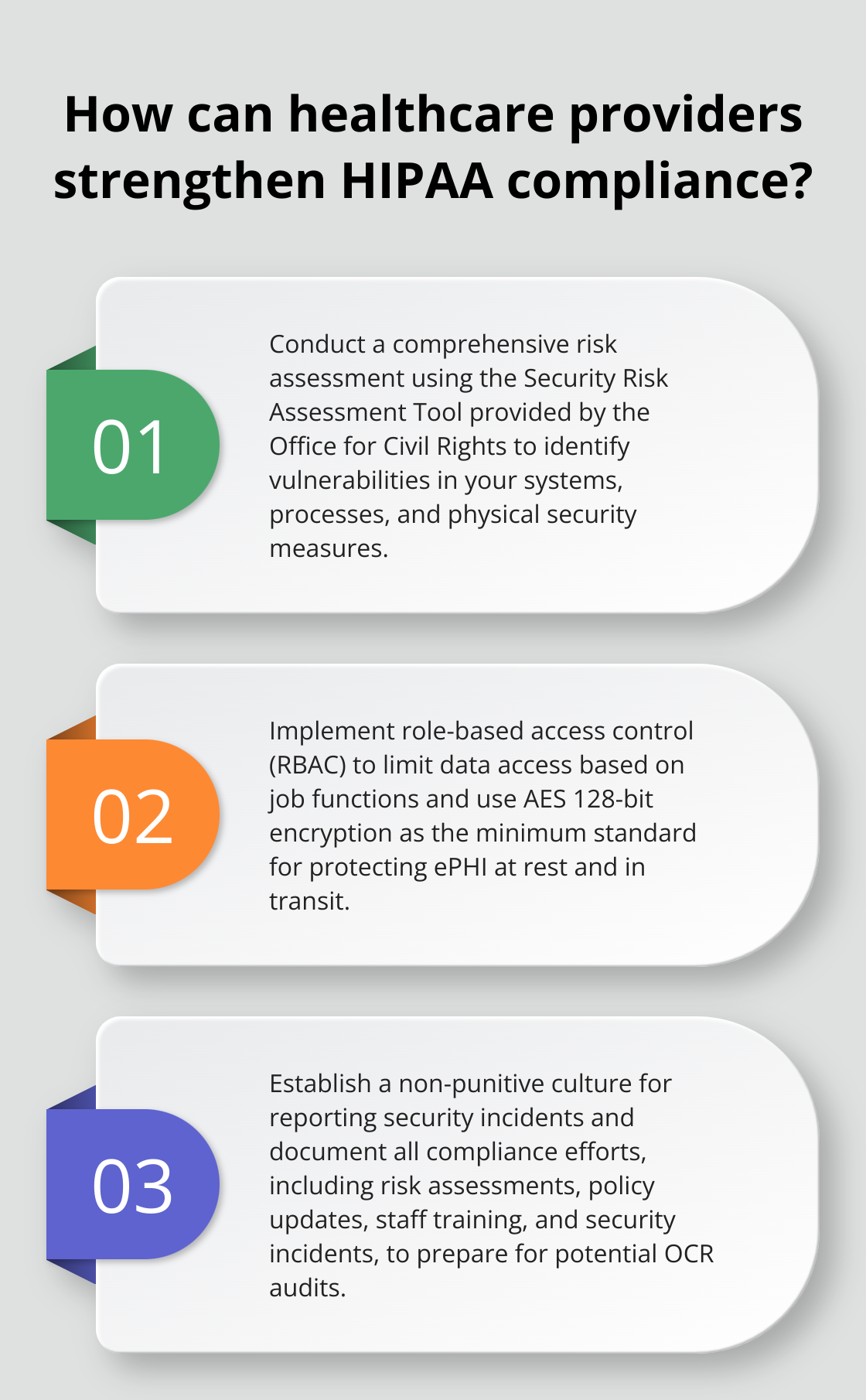Creating a HIPAA compliance policy template is a critical step for healthcare organizations to protect patient data and meet regulatory requirements. At ScriberJoy, we understand the complexities of HIPAA compliance and its impact on medical practices.
This guide will walk you through the essential elements of a HIPAA compliance policy template and provide practical steps for developing and implementing your own policy. We’ll cover key components, patient rights, security safeguards, and more to help you build a comprehensive HIPAA compliance strategy.
What Are HIPAA Compliance Requirements?
The Foundation of HIPAA Compliance
HIPAA compliance requirements form the backbone of patient data protection in healthcare organizations. These rules and regulations not only fulfill legal obligations but also maintain patient trust and ensure the integrity of healthcare operations.

The core of HIPAA compliance centers on two primary rules: the Privacy Rule and the Security Rule. The Privacy Rule establishes standards for the use and disclosure of Protected Health Information (PHI), while the Security Rule sets safeguards to protect electronic PHI (ePHI).
Healthcare organizations must implement various measures to comply with these rules. These include:
- Appointing a Privacy Officer
- Conducting regular risk assessments
- Establishing policies for data access, storage, and transmission
Essential Policy Components
A comprehensive HIPAA compliance policy should address several key areas:
- Patient Consent Procedures: The policy must outline how the organization obtains patient consent before sharing their information.
- PHI Safeguards: It should detail methods to protect PHI, both physically and electronically.
- Data Breach Response: The policy must include a plan for responding to and reporting data breaches.
- Employee Training: This often-overlooked component is critical. Regular, thorough training can significantly reduce the risk of data breaches.
The Importance of Policy Updates
HIPAA compliance requires constant vigilance. Healthcare organizations must review and update their policies regularly to address new threats and technological changes. The Office for Civil Rights (OCR) recommends (at minimum) annual reviews.
As healthcare technology evolves, so do the associated risks. For example, the surge in telehealth during the COVID-19 pandemic introduced new compliance challenges. Organizations that fail to keep their policies current face an increased risk of violations and potential fines.
In 2023, 725 data breaches were reported to OCR, exposing or impermissibly disclosing more than 133 million records.
The Role of Technology in Compliance
Modern technology plays a significant role in maintaining HIPAA compliance. Software solutions (like ScribeJoy for medical transcription) can help healthcare providers streamline their documentation processes while ensuring HIPAA compliance. These tools often include features such as:
- Secure data storage and transmission
- Access controls and user authentication
- Audit trails for all data access and modifications
The next chapter will explore the essential elements of a HIPAA compliance policy template, providing a roadmap for healthcare organizations to create robust, effective policies.
What Should a HIPAA Compliance Policy Template Include?
A robust HIPAA compliance policy template serves as the cornerstone of patient data protection in healthcare organizations. It creates a culture of privacy and security that permeates every aspect of operations.
Patient Rights and Consent
HIPAA compliance respects patient rights. Your policy must outline how patients can access their health information, request amendments, and receive an accounting of disclosures. The U.S. Department of Health and Human Services mandates that patients obtain a copy of their medical records within 30 days of their request. Your policy should detail this process (including any associated fees).

Consent forms play a vital role. Write them in plain language, explaining how you will use and share patient information. A study by the Journal of the American Medical Association revealed that only 54% of patients fully understood standard consent forms. To address this issue, use layered consent forms that provide information at different levels of detail.
Safeguarding Patient Data
Your policy must specify measures for protecting patient data. This includes both physical safeguards (locked file cabinets and restricted access areas) and technical safeguards (encryption and access controls).
For electronic Protected Health Information (ePHI), the National Institute of Standards and Technology (NIST) recommends AES-128, AES-192, or AES-256 bit encryption. Your policy should specify which encryption standards you use and how you implement them.
Address mobile devices in your policy. A survey by Spok found that 71% of clinicians use personal smartphones to access ePHI. Your policy needs to tackle this reality, perhaps by mandating the use of Mobile Device Management (MDM) software.
Breach Notification Procedures
Your policy must include a clear, step-by-step process for responding to and reporting breaches. The HIPAA Breach Notification Rule requires covered entities to notify affected individuals without unreasonable delay and in no case later than 60 days following the discovery of a breach.
Designate who will lead the breach response, how to assess the severity of a breach, and the specific steps for notifying patients, the media (if required), and the Office for Civil Rights.
Employee Training and Awareness
A policy proves effective only through proper implementation. Mandate regular employee training. Your policy should require annual HIPAA training for all employees, with additional training for new hires and when significant changes occur.
Implement a HIPAA compliance quiz after each training session. This reinforces learning and provides documentation of employee understanding, which can prove valuable during an audit.
Creating a HIPAA compliance policy template requires ongoing review and updates to stay current with evolving threats and regulations. The next chapter will guide you through the practical steps of developing and implementing your HIPAA compliance policy, ensuring you protect patient data effectively and maintain compliance.
How to Implement Your HIPAA Compliance Policy
Conduct a Comprehensive Risk Assessment
Start with a thorough risk assessment. This process requires a critical examination of your current practices. The Office for Civil Rights (OCR) provides a Security Risk Assessment Tool to guide you through this process. This desktop application uses a simple, wizard-based approach to walk users through the security risk assessment process.

Identify vulnerabilities in your systems and processes. Many data breaches could have been prevented with proper risk assessment and mitigation.
Assess physical risks too. Evaluate how you secure physical access to patient data and devices containing ePHI.
Tailor Your Policies to Your Organization
HIPAA compliance is not one-size-fits-all. Customize your policies based on your specific organizational structure, size, and the types of PHI you handle.
For instance, a small practice might not need the same level of access controls as a large hospital. However, you still need to ensure that only authorized personnel can access patient data. Consider implementing role-based access control (RBAC) to limit data access based on job functions.
Implement Robust Technical Safeguards
Technical safeguards serve as your first line of defense against data breaches. Implement strong encryption for all ePHI, both at rest and in transit. The absolute minimum standard is AES 128-bit encryption, as recommended by NIST to protect ePHI at rest and in transit.
Set up a system for regular software updates and patches.
Consider implementing multi-factor authentication (MFA) for accessing ePHI.
Establish a Culture of Compliance
HIPAA compliance isn’t just about technology; it’s about people. Train your staff regularly on HIPAA requirements and your specific policies. Make this training engaging and relevant. Use real-world scenarios and case studies to illustrate the importance of compliance.
Implement a system for reporting potential violations without fear of retaliation. The OCR emphasizes the importance of a non-punitive culture for reporting security incidents.
Monitor and Document Continuously
Compliance is an ongoing process, not a one-time event. Set up systems for continuous monitoring of your HIPAA compliance efforts. This includes regular audits of access logs, reviewing and updating policies, and staying informed about new threats and regulations.
Document everything. In the event of an OCR audit, comprehensive documentation can be your best defense. Keep detailed records of all your compliance efforts (including risk assessments, policy updates, staff training, and any security incidents or breaches).
Final Thoughts
Creating a HIPAA compliance policy template requires dedication and ongoing effort. Healthcare organizations must prioritize patient data protection through regular risk assessments, policy customization, and continuous monitoring. Technology plays a crucial role in maintaining compliance, with solutions like ScribeJoy offering secure data handling and customizable templates for medical transcription.

We at ScribeJoy understand the challenges of HIPAA compliance in medical documentation. Our medical transcription software supports healthcare providers in their compliance efforts while ensuring accurate and efficient documentation. The software combines AI technology with human verification to achieve high accuracy rates.
Healthcare providers can enhance their HIPAA compliance by utilizing technology solutions alongside their policy implementation. ScribeJoy’s tools can help streamline documentation processes while maintaining security standards. We encourage organizations to take proactive steps towards improved HIPAA compliance and experience the benefits of secure, efficient medical documentation.

Leave a Reply
You must be logged in to post a comment.